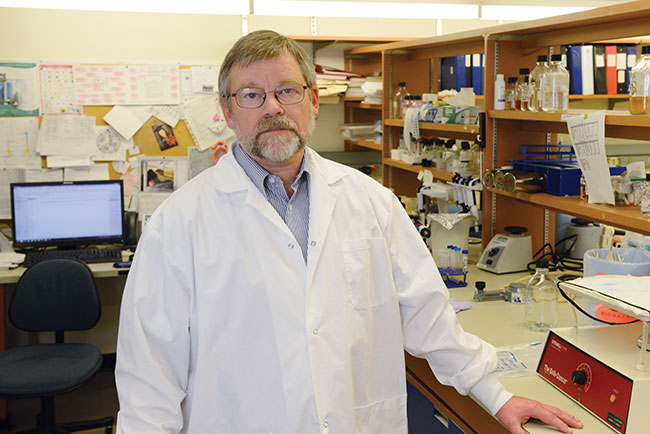
Follow the Science: Tackling yolk sac infections
By Lisa McLean
Features HealthResearchers in Saskatchewan believe they have found a way to make chicks less vulnerable to infection by stimulating the chick’s own natural immunity.
 Photo: Wolfgang Koester
Photo: Wolfgang Koester Yolk sac infection (YSI) is the most common cause of early chick mortality within a chick’s first two weeks of life. As the industry moves away from antibiotics to treat YSI, researchers in Saskatchewan believe they have found a way to make chicks less vulnerable to infection, by stimulating the chick’s own natural immunity.
Dr. Wolfgang Köster, Vaccine and Infectious Disease Organization (VIDO) and Department of Veterinary Microbiology, University of Saskatchewan, is leading research into the safe and effective use of immune stimulants. Administered in the right combination – and at the right time – the stimulants increase chicks’ natural immunity and make them less susceptible to pathogenic bacteria during those crucial early days after hatching.
“Antibiotics have been overused, and our only option for the future is to find an alternative,” Köster says. “We believe we can overcome this reliance on antibiotics by boosting innate immunity, an immune response that is not specific to any bacterium or virus.”
How to stimulate an immune system
In a previous stage of this project, Köster’s team identified four innate immune stimulants, which they administered as an in ovo injection. After hatching, chicks that had received each stimulant were challenged with an infection model that included a pathogenic strain of Escherichia coli. The researchers saw particular promise in one of the immune stimulants, known as CpG ODN.
“We have known the benefits of CpG ODN for some time, and in our most recent work we have been using it in different combinations and content ratios with other immune stimulants to see how they perform,” Köster says.
How YSI occurs
A chick’s yolk sac is crucial to early growth and development because it delivers nutrients and energy the chick needs to grow.
“Even the day before hatching, a yolk sac is still completely outside of the chick inside the egg,” Köster says. “It gets internalized within a day, but it takes some time to absorb the whole yolk material.”
When the yolk sac becomes infected with bacteria, the process of delivering nutrients and energy slows. Some chicks will grow at a slower rate, and some will die of systemic infection.
Second dose for staying power
By administering combinations of stimulants in ovo before hatching, Köster says the team was able to successfully stimulate innate immunity. When the treated birds hatched and were challenged with E. coli, they demonstrated immunity for approximately four to seven days. Köster notes chicks are still vulnerable to YSI up to 14 days.
“We decided to try adding a second dose of stimulants to extend the immunity,” he says. “in ovo injections are successful, but the effect doesn’t last as long as we’d like, so we added a second injection the day after hatch, and we found the innate immune response was enhanced.”
His team, including Drs. Arshud Dar, Thuy Nguyen and Colette Wheler, delivered the second dose to chicks subcutaneously (under the skin).
Köster says the project provided valuable insights about innate immunity and shows promise as an antibiotic alternative. And he notes future opportunities to expand on this research could aim to determine the ideal timing of that second subcutaneous dose. He suggests future work could also refine the most effective combinations of stimulants for optimal innate immunity.
“Sometimes one component works nicely, and another is satisfactory, but if you combine them, you might get a synergistic effect,” Köster says. “Sometimes two-and-two doesn’t make four. With the right combination, it might make six or eight – that is the value of further investigation as we continue to see bacteria and viruses, and our tools to manage them, evolve.”
This research is funded by the Canadian Poultry Research Council as part of the Poultry Science Cluster which is supported by Agriculture and Agri-Food Canada as part of the Canadian Agricultural Partnership, a federal-provincial-territorial initiative. Additional funding provided by the Saskatchewan Chicken Industry Development Fund (SCIDF).
Print this page